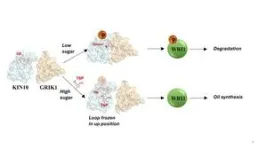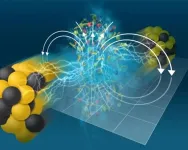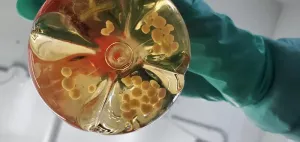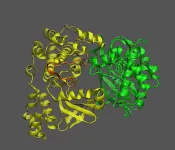(Press-News.org) PHILADELPHIA (May 16, 2024) – The rich research portfolio of the Monell Chemical Senses Center on sweet taste goes way back: Monell scientists were one of four teams in 2001 that found and described the mammalian sweet taste receptor – TAS1R2-TAS1R3. Twenty years later in 2021, a pair of papers published in Mammalian Genome by Monell researchers covered the genetics of sugar-loving mice.
The sweet taste receptor, expressed in taste bud cells, conveys sweetness from the mouth when it is activated. Earlier this month, a study in PLOS One, led by another Monell researcher, delved into how the sweet-taste receptor might be the first stop in a metabolic surveillance system for sugar. The receptor is also expressed in certain intestinal cells, where it may facilitate glucose absorption and assimilation, as part of this system.
The team found that stimulation and inhibition of TAS1R2-TAS1R3 demonstrates that it helps regulate glucose metabolism in humans and may have implications for managing such metabolic disorders as diabetes. Glucose is the primary type of sugar found in human blood, making it a key source of energy for cells.
“Our objective was to determine whether TAS1R2-TAS1R3 influences glucose metabolism in two directions,” said Monell Member Paul Breslin, PhD, Professor of Nutritional Sciences, Rutgers University, and senior author on the paper.
They showed that a TAS1R2-TAS1R3 agonist (sucralose, a zero-calorie sweetener) or a TAS1R2-TAS1R3 antagonist (lactisole, a sodium salt that inhibits sweet taste) mixed with a glucose meal acutely altered human glucose tolerance in different ways. Here, an agonist binds to a receptor and stimulates a cell and an antagonist binds to a receptor and prevents stimulation.
“The novelty of our findings is that the receptor we studied in this experiment impacts blood glucose and insulin during a glucose meal differently, depending on whether it is stimulated or inhibited,” said Breslin. This work provides further evidence that taste receptors help regulate metabolism and nutrient handling.
Plasma insulin levels were measured in study participants given an oral glucose tolerance test (OGTT), which follows blood sugar levels before and after a person drinks a liquid meal containing glucose. Participants’ ratings of perceived sucralose sweetness correlated with early increases in plasma glucose, as well as increases in plasma insulin levels when sucralose was added to the OGTT. The added sucralose tended to accelerate the release of insulin to the glucose load. On the other hand, participants’ sensitivity to lactisole-driven inhibition of sweetness was correlated with decreased plasma glucose levels. Lactisole also tended to slow insulin release.
“When glucose stimulates taste receptors before being absorbed into the body, signals are sent via the mouth and intestine to regulatory organs such as the pancreas. Perhaps, we could devise ways of using TAS1R2-TAS1R3 to help the body handle glucose better by anticipating when glucose will appear in the blood,” said Breslin. When the body senses glucose, it speeds up the absorption to deliver glucose to tissues that may need it and possibly also to prevent glucose from moving too far along the intestine, which may not be good for maintaining a healthy gut microbiome.
“This system is elegant in its simplicity,” said Breslin. The same taste receptor is all over the body – the mouth, gastrointestinal tract, pancreas, liver, and fat cells, with the last three being major metabolic regulatory tissues, all part of the body’s 24/7 metabolic watch.
Is there a relationship between a person’s health status and the activity of their TAS1R2-TAS1R3 receptors? Study authors say likely, suggesting that the degree of receptor activation exerts acute influences on plasma glucose and insulin levels and their timing of onset, which is important for metabolic health.
The team maintains that, in general, the current dietary habits of excessive consumption of food and beverages high in sucrose, high fructose corn syrup, and high-potency sweeteners could hyperstimulate TAS1R2-TAS1R3, contributing to the improper regulation of glucose in the blood. This could lead to a diagnosis of metabolic syndrome, a cluster of risk factors including elevated plasma glucose and insulin insensitivity (along with obesity, hypertension, and elevated plasma fats) that increases the risk of heart disease, stroke, and diabetes. The authors say that future studies should examine the effects of TAS1R2-TAS1R3 stimulation and inhibition in people who are at risk for metabolic syndrome to determine the therapeutic potential of manipulating TAS1R2-TAS1R3 for better metabolic control instead of worse.
“Studies like these – using Monell’s technical capability and deep expertise in the chemical senses – show that the sweet taste receptor TAS1R2-TAS1R3 helps to regulate glucose differently, depending on the sweetness of the food or beverage,” said Breslin. The team’s hope is to apply what they learned to make what we eat and drink healthier.
“A small metabolic change for the positive can add a lot more to the life and health of humans when compounded over decades and millions of people,” said Breslin.
Editor’s note
Along with Breslin, co-authors are Emily C. Hanselman and Matthew C. Kochem, Department of Nutritional Sciences, Rutgers University, New Brunswick, NJ.
This work was supported by the National Institutes of Health (R01 DC014286, R21 DC020365) and the University of Pennsylvania Diabetes Research Center for the use of the Metabolomics Core (P30-DK19525).
###
The Monell Chemical Senses Center is an independent nonprofit research institute in Philadelphia, Pennsylvania. Monell was founded in 1968, and its mission is to improve health and well-being by advancing the scientific understanding of taste, smell, and related senses, where our discoveries lead to improving nutritional health, diagnosing and treating disease, addressing smell and taste loss, and digitizing chemosensory data.
END
Sweet taste receptor affects how glucose is handled metabolically by humans
Study points to new potential areas for managing metabolic disorders, such as diabetes
2024-05-17
ELSE PRESS RELEASES FROM THIS DATE:
STAR sees a magnetic imprint on deconfined nuclear matter
2024-05-17
The Science
Scientists have the first direct evidence that the powerful magnetic fields created in off-center collisions of atomic nuclei induce an electric current in “deconfined” nuclear matter. This is a plasma “soup” of quarks and gluons that have been set free, or “deconfined,” from nuclear matter—protons and neutrons—in the particle collisions. The magnetic fields in deconfined nuclear matter are a billion times stronger than a typical refrigerator magnet, but their effects can be hard to detect. This new study’s evidence is from measuring the way ...
CU faculty member receives prestigious award for health equity work
2024-05-17
In recognition of her exceptional work in advancing health equity, the Society of General Internal Medicine (SGIM) bestowed its 2024 Herbert W. Nickens Award to Rita Lee, MD, a University of Colorado Department of Medicine faculty member, at a May 17 meeting in Boston.
“The committee has chosen to honor you as an exemplary SGIM member who has made prioritizing minority health and diversity the primary focus of your career,” Alana Biggers, MD, MPH, the chair of the award selection committee, said in a congratulatory letter to Lee.
The ...
Better medical record-keeping needed to fight antibiotic overuse, studies suggest
2024-05-17
A lack of detailed record-keeping in clinics and emergency departments may be getting in the way of reducing the inappropriate use of antibiotics, a pair of new studies by a pair of University of Michigan physicians and their colleagues suggests.
In one of the studies, about 10% of children and 35% of adults who got an antibiotic prescription during an office visit had no specific reason for the antibiotic in their record.
The rate of this type of prescribing is especially high in adults treated seen in emergency departments and in adults seen in clinics who have Medicaid coverage or no insurance, the ...
Clinicians report success with first test of drug in a patient with life-threatening blood clotting disorder
2024-05-17
Key Takeaways
Immune thrombotic thrombocytopenic purpura, a rare blood clotting disorder, results from an autoimmune attack against an enzyme called ADAMTS13
A recombinant form of human ADAMTS13 approved for a different condition helped to save the life of a young mother with immune thrombotic thrombocytopenic purpura
Results from this first use of the drug for this condition—by a team led by researchers from Massachusetts General Hospital—warrants testing the drug in a clinical trial
A team led by investigators from Massachusetts General Hospital, a founding member of the Mass General Brigham healthcare system, used a new drug to save the life of a patient ...
NIH study shows chronic wasting disease unlikely to move from animals to people
2024-05-17
WHAT:
A new study of prion diseases, using a human cerebral organoid model, suggests there is a substantial species barrier preventing transmission of chronic wasting disease (CWD) from cervids—deer, elk and moose—to people. The findings, from National Institutes of Health scientists and published in Emerging Infectious Diseases, are consistent with decades of similar research in animal models at the NIH’s National Institute of Allergy and Infectious Diseases (NIAID).
Prion diseases are degenerative diseases found in some mammals. These diseases primarily involve deterioration of the brain but also can affect the eyes and other organs. ...
Scientists discover mechanism of sugar signaling in plants
2024-05-17
UPTON, N.Y. — Proteins are molecular machines, with flexible pieces and moving parts. Understanding how these parts move helps scientists unravel the function a protein plays in living things — and potentially how to change its effects. Biochemists at the U.S. Department of Energy’s (DOE) Brookhaven National Laboratory and colleagues at DOE’s Pacific Northwest National Laboratory (PNNL) have just published a new example of how one such molecular machine works.
Their paper in the journal Science Advances describes how the moving parts of ...
Cleveland Clinic research finds VISTA directly blocks T-cells from functioning in immunotherapy
2024-05-17
A Cleveland Clinic-led team of scientists and physicians have discovered that the immune checkpoint protein VISTA can directly turn off tumor-fighting T-cells during immunotherapy and resist treatment.
The study, published in Science Immunology, explains that VISTA can bind to a protein called LRIG1 in T cells, which was previously only thought to promote bone and fat development. When VISTA binds to LRIG1, the researchers found, LRIG1 sends signals that suppress T cell replication, survival ...
Pagan-Christian trade networks supplied horses from overseas for the last horse sacrifices in Europe
2024-05-17
Horses crossed the Baltic Sea in ships during the Late Viking Age and were sacrificed for funeral rituals, according to research from Cardiff University.
Published in the journal Science Advances, studies on the remains of horses found at ancient burial sites in Russia and Lithuania show that they were brought overseas from Scandinavia utilising expansive trade networks connecting the Viking world with the Byzantine and Arab Empires.
Up to now, researchers had believed sacrificial horses were always locally-sourced stallions. ...
University of Bristol researchers develop world’s smallest quantum light detector on a silicon chip
2024-05-17
Researchers at the University of Bristol have made an important breakthrough in scaling quantum technology by integrating the world’s tiniest quantum light detector onto a silicon chip.
A critical moment in unlocking the information age was when scientists and engineers were first able to miniaturise transistors onto cheap micro-chips in the 1960s.
Now, for the first time, University of Bristol academics have demonstrated the integration of a quantum light detector – smaller than a human hair – onto a silicon chip, moving us one step closer to the age of quantum technologies using light.
Making high performance electronics ...
Gut bacteria boost immune response to fight tumors
2024-05-17
Roughly one in five cancer patients benefits from immunotherapy – a treatment that harnesses the immune system to fight cancer. Such an approach to beating cancer has seen significant success in lung cancer and melanoma, among others. Optimistic about its potential, researchers are exploring strategies to improve immunotherapy for cancers that don’t respond well to the treatment, with the hope of benefiting more patients.
Now, researchers at Washington University School of Medicine in St. Louis have found, in ...
LAST 30 PRESS RELEASES:
SwRI upgrades nuclear magnetic resonance laboratory for pharmaceutical R&D
House sparrows in northern Norway can help us save other endangered animals
Crohn's & Colitis Foundation survey reveals more than 1/3 of young adults with IBD face step therapy insurance barriers
Tethered UAV autonomous knotting on environmental structures for transport
Decentralized social media platforms unlock authentic consumer feedback
American Pediatric Society announces Vanderbilt University School of Medicine as host institution for APS Howland Visiting Professor Program
Scientists discover first method to safely back up quantum information
A role for orange pigments in birds and human redheads
Pathways to net-zero greenhouse gas emissions for Southeast Asia
A JBNU–KIMS collaborative study on a cost-effective alloy matches superalloys for power plants and energy infrastructure
New study overturns long-held model of how plants coordinate immune responses.
New AI model predicts disease risk while you sleep
Scientists discover molecular ‘reshuffle’ and crack an 80-year-old conundrum
How stressors during pregnancy impact the developing fetal brain
Electrons lag behind the nucleus
From fungi to brain cells: one scientist's winding path reveals how epigenomics shapes neural destiny
Schizophrenia and osteoporosis share 195 genetic loci, highlighting unexpected biological bridges between brain and bone
Schizophrenia-linked genetic variant renders key brain receptor completely unresponsive to both natural and therapeutic compounds
Innovative review reveals overlooked complexity in cellular energy sensor's dual roles in Alzheimer's disease
Autism research reframed: Why heterogeneity is the data, not the noise
Brazil's genetic treasure trove: supercentenarians reveal secrets of extreme human longevity
The (metabolic) cost of life
CFRI special issue call for papers: New Frontiers in Sustainable Finance
HKU Engineering scholar demonstrates the smallest all-printed infrared photodetectors to date
Precision empowerment for brain "eavesdropping": CAS team develops triple-electrode integrated functional electrode for simultaneous monitoring of neural signals and chemical transmitters during sleep
Single-capillary endothelial dysfunction resolved by optoacoustic mesoscopy
HKU three research projects named among ‘Top 10 Innovation & Technology News in Hong Kong 2025’ showcasing excellence in research and technology transfer
NLRSeek: A reannotation-based pipeline for mining missing NLR genes in sequenced genomes
A strand and whole genome duplication–aware collinear gene identification tool
Light storage in light cages: A revolutionary approach to on-chip quantum memories
[Press-News.org] Sweet taste receptor affects how glucose is handled metabolically by humansStudy points to new potential areas for managing metabolic disorders, such as diabetes







